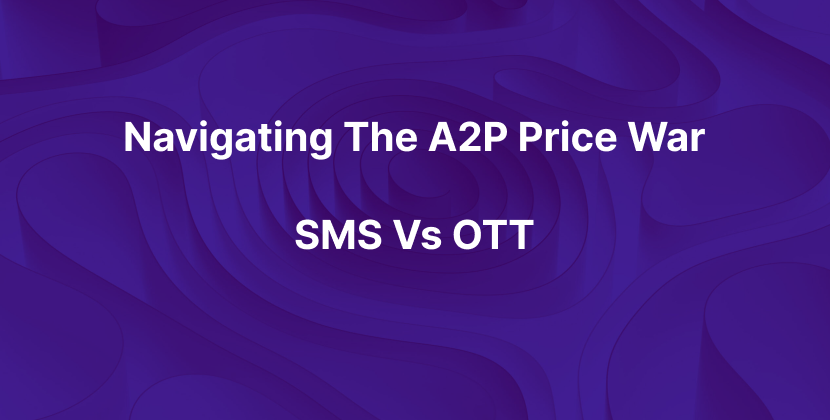
Navigating the A2P price war – SMS vs OTT
The world of mobile messaging has witnessed a seismic shift in recent years with the proliferation of Over-The-Top (OTT) messaging platforms like WhatsApp, Viber, RCS and Apple iMessage.
These platforms have not only revolutionised personal communication but also disrupted the traditional A2P (Application-to-Person) SMS market.
In this article, HAUD experts Joanna Kuligowska and Ron Bonnici explore two crucial themes: defining a pricing strategy for A2P SMS in an age of growing OTT proliferation; and secondly – identifying the local price ceiling for A2P messages so you don’t inadvertently undermine your own market and further open the door to OTT.
“You have to acknowledge a price war”
A2P SMS messaging has long been a reliable means of communication for businesses, with enviable open rates and near universal delivery capabilities – but the rise of OTT players has ignited a cost competition that MNOs must confront.
For Ron, the first stage in defining a pricing structure is to be super clear on the client value OTT services deliver – and why they are being successful.
He said: “I think the first thing I would look at are the new channels that are coming – and the business pricing models they are launching. By that I mean the OTT players. Whatsapp recently launched a pricing model, Viber were the first to enter the business messaging space with differentiated pricing, and don’t forget Google RCS and Apple Business Chat (ABC)”.
“These players are effectively providing brand messaging APIs, where the delivery infrastructure is free – via the MNO’s assets and the termination price both for domestic and international is low. Which means you have to acknowledge a price war when it comes to A2P and wider business messaging.”
“Who will win this is based on the right pricing strategy – hence why looking at them first is a good idea as they are the biggest threat to this revenue stream for MNOs and aggregators – their data helps underpin the next stage in pricing strategy.”
In the last article in this series, Jo and Ron outlined the kind of framework HAUD uses to help clients design an optimised structure – based on market data, elasticity, and creating a stable operating environment for brands wanting to send A2P or business SMS messages.
The next step, argues Ron, is to go more granular and to start to put a value on the category of the message.
He said: “I think the next thing to consider is the type, purpose and timeliness of the messages you are delivering.”
“You need to put a value on that message. So am I protecting something? Am I protecting a customer’s bank account? Am I protecting social media accounts, or even healthcare information? Am I alerting someone of the need to get to a departure gate or they’ll miss their flight. Or am I asking for further information to speed up a booking or contraction of a service.
“Or, is it marketing specific to a customer – and in which case what is being sold. All of these variations impact the ‘value’ of an individual message.”
Lastly, MNO’s have to look at their own opex. To stay competitive, MNOs should assess their costs and revenue streams carefully. Understanding the cost structure of A2P SMS, including infrastructure, maintenance, and operational expenses, is vital. By juxtaposing these costs with potential revenue streams, MNOs can determine their pricing sweet spot.
This matters, because the next stage is introducing differentiated pricing based on all that value insight you’ve gained – the OTT value add to clients, the value of the messaging you are delivering, and the cost of doing this. Combined, they’ll lead you to better understand where and how you can flex your own prices.
But before you can do that, two words of warning.
Firstly, how you flex your pricing is a balancing act – while differentiated pricing is great for the MNO, for the big brands using your service, they want stability in pricing. They need a level of certainty in messaging costs so they can build that into yearly communication budgets. Move things around too much, and you’ll upset them and cause unnecessary churn.
Secondly, you also need to understand the price ceiling for your region. Spotting that requires looking out for a number of key things.
Joanna said: “The most obvious symptom is that your traffic stops growing – or even dropping, which is usually a clear indicator the pricing is too high for the brands in your region.
“The second symptom is often increased use of grey or illegitimate traffic – higher prices are clearly an incentive for some organisation to find network vulnerabilities – like domestic P2P routes – and use them to bypass fees.
“We’re seeing increases at the moment in explosive traffic trashing events – with blended traffic across legitimate and illegitimate routes making it harder to spot.
“Another clear sign is erosion in some traffic types – marketing for example, which gets shifted to email. Meanwhile, you start seeing some increases in both the OTT traffic, as Ron just spoke about, and flash calling ID services etc. Basically it all amounts to a drop off in revenue generation.”
And that last point, really, is key – it’s loss of revenue that an MNO and its wholesale partners both should be getting, and could easily avoid losing – if they get the pricing right.
However, MNOs must also consider regulatory factors that may influence pricing. Local regulations can dictate price controls, interconnect fees, and other pricing-related aspects. Compliance with these regulations is essential to avoid legal issues and maintain a positive reputation – but they are also a key factor in determining where and how high your local ceiling can go.
In the age of OTT competition, defining a pricing strategy for A2P SMS messaging is a complex task for Mobile Network Operators. Understanding the competitive landscape, assessing costs, offering tailored pricing plans, and staying agile in strategy are essential steps to navigate this challenge successfully.
Identifying the local price ceiling requires thorough market research, compliance with local regulations, benchmarking against OTT competitors, gathering customer feedback, and ongoing optimization.
However, it’s worth it. By addressing these two themes, MNOs can position themselves strategically in the evolving A2P SMS market and tap into what should be a fast-growing messaging market as use cases iterate and get innovated.
As always, we’d love to hear your thoughts on these topics, so do share any feedback or ideas via this contact form:

Share your thoughts and ideas with HAUD
Speak with one of our messaging revenue specialists